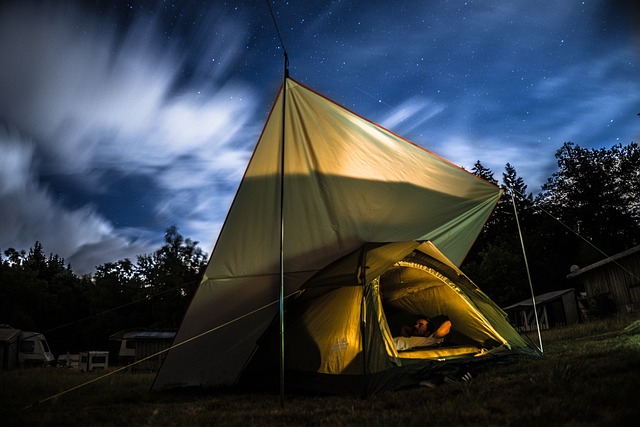This post contains affiliate links.
Often, It is not until after a tent is purchased that extensions are considered, especially after a camping trip. The extension may be to add additional living space, kitchen area or shelter during wet weather. Tent extensions are costly, but there is a different way to extend a tent without spending over £100.
As a general rule, tarps provide additional shelter and storage. They can also be placed over a tent to protect against rain and falling debris. Tarps are coated with a chemical agent to protect against UV damage and waterproofing, prolonging the lifespan and reducing maintenance.
Universal tent awnings and tarps are a cheap way to gain additional covered area for a tent. There are several ways a tent can be extended cheaply and adapted for various scenarios. Either due to lack of funds, tent discontinued, or it needed for more than one tent.
Why use a tarp and what are they?
Tarps are a great way to extend a tent without spending on average £200 – £400. Especially if money is tight or you have several tents that you want to expand.
Unless a tent extension is purchased simultaneously as a tent, it can be hard to find a suitable extension. Tent designs change each season, and dimensions vary, making it impossible at times to buy a new extension at a later date.
Tarps are not the same as a tent extension. They do not attach directly, providing a zipped enclosed living area. However, they offer suitable protection against the elements—ample coverage for a kitchen and additional shelter for an eating area or keeping furniture dry.
They can be used over multiple entrances and adapted quickly to suit. Plus, the small financial outlay does not break the bank to buy another tarp later.
Specific tent extensions are bulky and can be challenging to fit into a car for travelling, mainly if limited space. However, tarps pack small, lightweight, and easier to transport, primarily if you use public transport.
Ways to use a tarp:
- Backpacking – additional shelter over the entrance of a small tent
- Hammock camping – provide shelter over hammock
- Wild camping – temporary shelt without a tent or cover over a main entrance
- Car camping – shelter for eating and additional space
Windbreakers provide additional privacy by positioning along the side and front of a tarp. If you are not concerned about having a sealed enclosed area, tarps are a great option.
A good quality tarp will cost no more than £39.99, plus telescopic poles costing on average £15.29. Prices may vary depending on size, quality, shape and where you buy. Guy lines, pegs are supplied with the tarp and poles.
If a tarp is not suitable, another option is Coleman Classic Awning costing £59.99 (prices may vary). The difference between a tarp and the Colemans Classic Awning is an arched fibreglass pole at the main entrance, which is adjustable.
There are no concerns about the front end collapsing—the fibreglass pole clips on either end into an adjustable strap that lays on the ground. The main body is placed over your tent, either entirely, or halfway depending on the length of shelter you require.
The awning does not have sides and can be adapted using windbreakers the same as a tarp.
I prefer the Colemans Classic Awning for long camping trips. When packed, it is bulkier than a tarp but is sturdy and provides a more sheltered area to store furniture. I use my tarp for short camping trips, typically 1-2 nights. Or whilst wild or car camping.
I love car camping, but it can be a nightmare if it rains and you need somewhere to cook. A tarp is easy to set up, hardly takes up any space, and is very easy to pack when you have finished. Plus, it can be secured to use as additional privacy at the back of a car.
If you prefer a tent extension to a tarp or a Colemans Classic Awning, you may be able to buy one on ebay or Facebook Market Place. But before you buy we have created a checklist of things you need to be aware of, such a mould, removing smells. Also understanding what can be repaired and when to walk away.
Benefits of using a tarp awning instead of a tent extension
| Pros | Cons |
|---|---|
| Much cheaper than tent extensions – ideal for low budget | No sides |
| Adaptable for all circumstances | Not as stable as tent extensions |
| Easy to store | They can be a nightmare to set up |
| Can move to different areas of a pitch | No protection against bugs |
| Ideal shelter for storing muddy clothes or boots | No protection from wind unless you use a windbreaker |
| Do not require poles, can be attached to surround trees, hedges | No protection against wind-driven rain |
| Shade from the sun or rain | Noisy at night as the wind catches the tarp |
| Lightweight | |
| Ideal for smaller tents that do not have standing room. | |
| Great for overnight camping trips – wild camping, car camping |
What is the difference: Extension, tarp, awning and canopy
It can be confusing when considering ways to extend a tent, add shelter or booking a campsite pitch. Many campsites will often class tent extensions and canopies as awnings.
Awnings are generally associated with caravans that are fixed to the side, providing additional shelter.
- Canopy and tent extentions: Close enclosed areas that attached to a tent, providing additonal living space or shelter.
- Awning: Associated with caravans that is fixed and provides additional shelter. Can either be temporarily fixed to the side of a caravan, enclosed or roof shelter only.
- Tarp: A tarpauling that can either be used as a footprint or additonal shelter using guy ropes, poles and pegs to secure.
Tent extension – Colemans Classic Awning

Colemans Classic Awning is a cheap way to add extra space to a tent without breaking the bank. Not only is it reasonably priced at £59.99. Price may vary. It can be adapted to use for more than one tent.
What do you get with the Colemans classic awning? Guy ropes, pegs and an arched fibreglass pole with the shelter. The front has a strap that lays directly on the floor and is adjusted to the required width. For additional support, especially in the heavy wind, adding a pole in the centre to support.
The awning is placed over the top of your tent and secured with guy lines behind and side. It can be attached to a tent, the same way as a tent extension. I prefer to lay over my tent due to the length of the awning, making it more secure.
The only drawback of a Colemans Classic Awning is the difficulty of placing over your tent to peg. Especially in windy conditions. You will need more than one person unless you have a smaller tent or in a sheltered area.
In general, awnings are easy to adjust to suit the area you have. I like to add quite a bit of space, not only for cooking but for places to sit, dry clothes and store furniture during the night. Just in case it rains.
Tarps for camping: How adaptable are they?


Tarp awnings have several different uses. Not only for adding sheltered areas for cooking, weather, and can be used to add cover whilst you pitch a tent.
A good tarp is strong, with double stitched seams and tie-downs with a silver underside for reflecting body heat. Available in different colours
Tarps are available in various shapes, either square, rectangle, triangle and sizes. Standard tarp size is:
- 300 cm x 300 cm
- 300 cm x 400 cm
- 300 cm x 500 cm
It is essential to consider the direction of the wind to avoid damage to the tarp. Place the tarp lower on the side of the wind with a windbreaker for additional protection. Otherwise, you will always be concerned that the tarp will blow away.
During our last camping trip, we connected two tents using two awnings, Providing us with a large area for cooking and plenty of room to store all of our furniture during the night. However, tents should have 6m between each tent due to fire hazards.
The only downside of a tarp is having the additional expense of buying poles as they are not supplied.
Related questions
Are tent extensions worth buying?
All tents are unique, and it is vital to purchase the exact style and compatibility for a tents specification: either front porches or side porches. Universal extensions are available in size ranges that are suitable for more than one tent. It is essential to check that the tent is compatible with the size range. Prices can range from £300 – £500.
How to use a gazebo to shelter a tent
Gazebos are easy to extend a tent, providing additional shelter, but it will not be an exact fit. They are ideal for smaller tents, as they can be placed partly underneath one side of a gazebo. Which will help protect against rain entering a tent.
Alternatively, placed near the entrance of a larger tent using a tarp to provide additional shelter between a tent and a gazebo.
I often use our Eurohike Genus gazebo for sheltering the entrance to my tiny tent. Not only providing a dry area but additional privacy by using the side walls. It is a cheaper option than buying an extension and can be used for entertaining in your back garden as well as camping.


